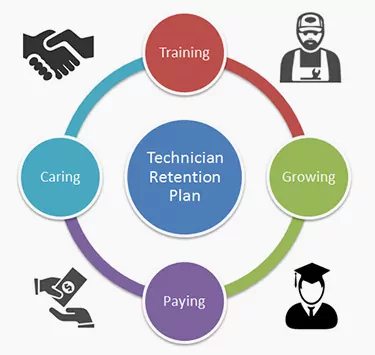With the shortage of qualified technicians in the workforce, not only is it daunting to find good candidates for hire, but your competitors, who are facing the same issue, are working harder to recruit your qualified technicians.

While the lack of capable new hires is discouraging, the technician turnover rate is simply alarming. The annualized turnover rate for service technicians last year was a whopping 24%, according to the NADA 2015 Workforce Study*. That means a dealership with 8 technicians can expect to lose 2 this year. Where will that leave your dealership?
The revolving door in your fixed operations is costly and frustrating. It’s time to “stop the bleeding” and keep the technicians you have. Here is part 1 of a few retention plan best practices to help you do just that.
Training Paths As a Retention Plan
Having spent years as a service manager myself, and later as an OEM District Manager, I can fully relate to the factory telling you all about your technicians’ under-benchmark training numbers. Sure, technicians need to properly diagnose and repair, and keep warranty ratios in line, but how do they see their training? Is it just something they have to do or an investment in helping them build their career? You know your intentions. Make sure your technicians do too.
- Define Individual Training Paths:
- Make training personal. Tailor each technician’s training path to his/her skill level and growth potential. Some can complete training modules and retain the knowledge at a quicker pace than others. Individualized paths make training a push, not a pull.
- Follow your OEM’s path, being sure to give expected completion dates that are realistic for the workload. Create a contingency plan for overdue classes that may include blocking off the technician’s schedule if necessary.
- Inspect what you expect. Put monthly or quarterly training path reviews on your calendar. Sit down and have a two-way conversation with each technician so they know they have a voice.
- Post-training, give them the opportunity to put the knowledge to work and retain the information. A technician that has just completed HVAC training should be given the opportunity to diagnose an A/C concern.
- A technician with a higher percentage of completed training and more skill is simply worth more money. Why? More efficient diagnosis and repair has a real impact on the bottom line. Make rate increases a component of the training path. Lay out the levels that must be reached and the pay increase associated with each level. Make it a big deal when a technician hits his or her goal!
- Make training personal. Tailor each technician’s training path to his/her skill level and growth potential. Some can complete training modules and retain the knowledge at a quicker pace than others. Individualized paths make training a push, not a pull.
- Follow your OEM’s path, being sure to give expected completion dates that are realistic for the workload. Create a contingency plan for overdue classes that may include blocking off the technician’s schedule if necessary.
- Inspect what you expect. Put monthly or quarterly training path reviews on your calendar. Sit down and have a two-way conversation with each technician so they know they have a voice.
- Post-training, give them the opportunity to put the knowledge to work and retain the information. A technician that has just completed HVAC training should be given the opportunity to diagnose an A/C concern.
- A technician with a higher percentage of completed training and more skill is simply worth more money. Why? More efficient diagnosis and repair has a real impact on the bottom line. Make rate increases a component of the training path. Lay out the levels that must be reached and the pay increase associated with each level. Make it a big deal when a technician hits his or her goal!
- Make training personal. Tailor each technician’s training path to his/her skill level and growth potential. Some can complete training modules and retain the knowledge at a quicker pace than others. Individualized paths make training a push, not a pull.
- Follow your OEM’s path, being sure to give expected completion dates that are realistic for the workload. Create a contingency plan for overdue classes that may include blocking off the technician’s schedule if necessary.
- Inspect what you expect. Put monthly or quarterly training path reviews on your calendar. Sit down and have a two-way conversation with each technician so they know they have a voice.
- Post-training, give them the opportunity to put the knowledge to work and retain the information. A technician that has just completed HVAC training should be given the opportunity to diagnose an A/C concern.
- A technician with a higher percentage of completed training and more skill is simply worth more money. Why? More efficient diagnosis and repair has a real impact on the bottom line. Make rate increases a component of the training path. Lay out the levels that must be reached and the pay increase associated with each level. Make it a big deal when a technician hits his or her goal!
- Make training personal. Tailor each technician’s training path to his/her skill level and growth potential. Some can complete training modules and retain the knowledge at a quicker pace than others. Individualized paths make training a push, not a pull.
- Follow your OEM’s path, being sure to give expected completion dates that are realistic for the workload. Create a contingency plan for overdue classes that may include blocking off the technician’s schedule if necessary.
- Inspect what you expect. Put monthly or quarterly training path reviews on your calendar. Sit down and have a two-way conversation with each technician so they know they have a voice.
- Post-training, give them the opportunity to put the knowledge to work and retain the information. A technician that has just completed HVAC training should be given the opportunity to diagnose an A/C concern.
- A technician with a higher percentage of completed training and more skill is simply worth more money. Why? More efficient diagnosis and repair has a real impact on the bottom line. Make rate increases a component of the training path. Lay out the levels that must be reached and the pay increase associated with each level. Make it a big deal when a technician hits his or her goal!
- Promote ASE Certifications:
- ASE certifications are a great way to validate your technicians’ knowledge, ability, and experience. They also build tremendous trust with your customers who know their vehicles are being repaired by ASE certified technicians.
- Some OEMs make ASE certifications part of their requirements. If yours doesn’t, be sure you Include ASE tests in your technicians’ training paths, placed in line with the OEM courses.
- Making it easy for your technicians to complete these certification tests will produce less push back. Keep track of recertification dates, schedule the tests, and pay for the fee to take tests (passing grade only). Sweeten the pot with a bonus for each test passed.
- Display each technician’s certifications proudly where your customers can see them. This display sends a message to your customers about the quality of your service and, more importantly, reinforces to your technicians the value, respect, and pride you have in their achievements.
- Get started at ase.com/home.aspx.
- Encourage State Inspection Licenses:
- Motivate your technicians to obtain their licenses by including them in the training paths. Keep track of their license renewal dates and help them get recertified.
- Most states with inspections will offer to send a trainer to you for a minimum headcount. Get all of your technicians on the same schedule and offer to hold an in-house recertification class to save them the time and trouble of traveling off site.
- Consider covering all or part of the cost to obtain inspection licenses and renewals. Remember, these inspections are beneficial not only to the technician, but also to your store.
Are you catching the vision and seeing the value in retention? Stay tuned for part 2. In it, I will discuss “growing” your best technicians from students still in training.
* “NADA Study Reveals 71 Percent Turnover for Dealership Sales Positions,” October 27, 2015, www.drivingsales.com/news/nada-study-reveals-71-percent-turnover-for-dealership-sales-positions/
Explore more resources
Repeat Customers Are Gained From Great Customer Service
Dealerships that thrive never forget this simple truth: take care of your customers, and they’ll take care of you.
Maximize Efficiency & Customer Satisfaction in Your Dealership
This article aims to provide you with the knowledge necessary to optimize your dealership’s performance and ensure delighted customers every…
One Family’s Journey in Automotive
Black History Month is a powerful reminder to all Americans and the world of our undeniable impact on this country….
Stay up to date
Subscribe to get the latest auto industry insights from Autosoft experts





